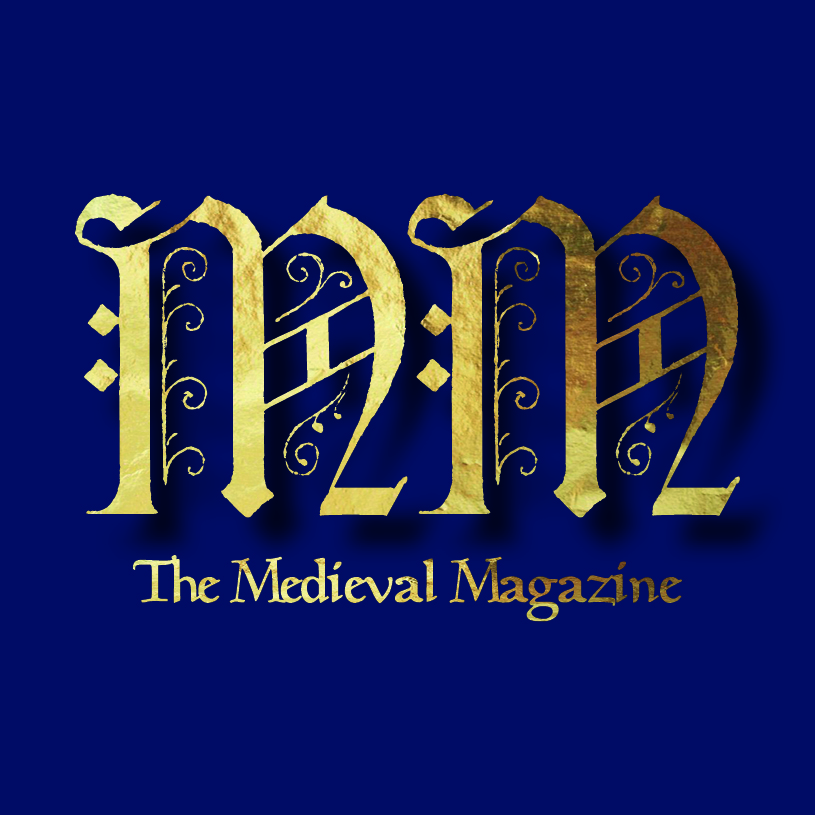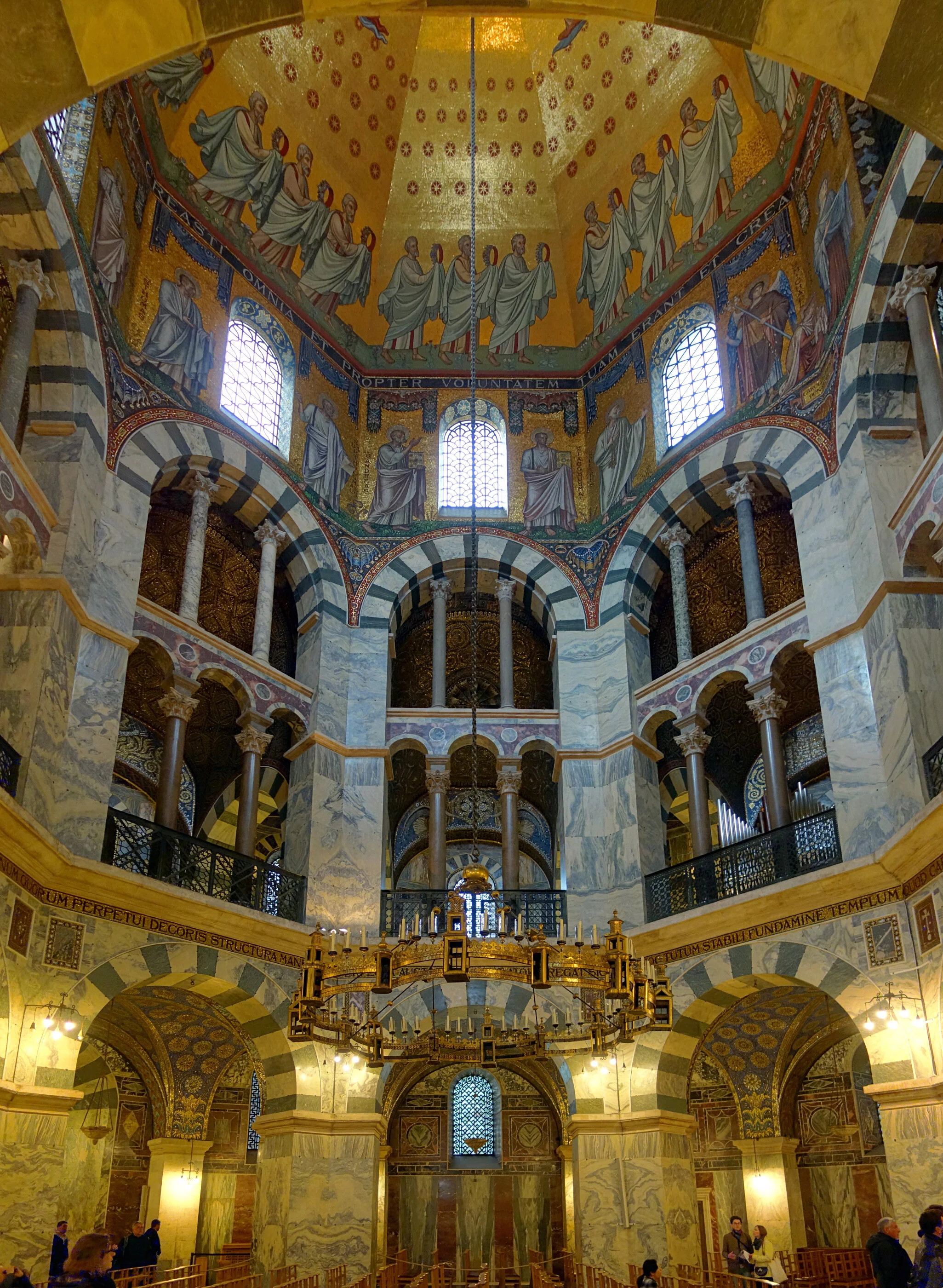Mirror of an empire Charlemagne’s Palatine Chapel By Jo’anne van Ooijen
The ‘Carolingian Renaissance’ of the late eighth and ninth century brought about a revival in education, literature, arts, architecture, and legal studies. It has often been interpreted as an attempt to revive the spirit of the Roman empire, but there was more to it than that. The world had changed drastically since Roman times. Charlemagne’s reign covered many regions and peoples across the vast territory that was united under his rule, but lacked cultural cohesion. The Palatine Chapel in Aachen is the most important architectural testimony of the Carolingian era. It combines different architectural influences that together mirror the multifaceted Carolingian world.
Palatine Chapel. Photo: Velvet via Wikimedia Commons
The palace complex in Aachen and the adjoining Palatine Chapel (begun c. 792) are often read as part of Charlemagne’s ambition to turn Aachen into a ‘second Rome’, which is supported by the Paderborn Epic (c. 802). This fits the image of the Carolingian Renaissance as a revival of the Roman empire with Aachen as central capital. But the situation was more complex. Aachen was not a capital in name or function, nor is there evidence that Charlemagne had marked it as such. At the time, the Carolingian court was itinerant, covering large distances to control a large territory. Royal palaces were scattered over cities, and in the countryside. Archaeological evidence of them is scarce because these palaces were mostly constructed in wood. The palace in Aachen is lost as well. But the Palatine Chapel was constructed in stone and survived.Today, it is incorporated in the larger Cathedral complex, dating from later periods.
For the Palatine Chapel, Charlemagne and his architect Odo of Metz (742–814)carefully selected examples and material from a variety of sources. That ensured that its design, materials and building techniques reflected the different aspects of the Carolingian world. A closer look at these sources sheds light on how Charlemagne wanted to present himself and his reign.
Ravenna’s Carolingian inspiration
The central building plan of the Chapel is modelled closely on the church of San Vitale in Ravenna. It is organized around an octagon that carries the two storey elevation with heavy pillars supporting the dome. A sixteen sided ambulatory surrounds the octagon and supports the gallery. The association with Ravenna connected the Chapel not only with the Italian peninsula, but also with the Byzantine empire.
Ravenna was under papal rule in the eighth century, but still closely associated with Byzantium. It had functioned as its Western capital and still radiated with magnificent, albeit neglected, Byzantine art and architecture. Charlemagne had visited Ravenna several times and must have been awed by its architectural wonders, such as the Byzantine churches of Sant’Apollinare in Classe, and San Vitale. Politically speaking, Ravenna stood at the intersection of the antique Roman world, and the medieval superpower of Constantinople. Culturally, it represented both the Christian world and the opulence of the East. It is not surprising that Charlemagne was inspired.
The Palatine Chapel also drew on sources closer to home. Across from the apsis in the east with its Byzantine style mosaic, the atrium in the west leads to the entrance portal flanked by two towers. This entrance ensemble, indicated as a ‘westwork’, was a Frankish innovation that became typical for German and French churches built in the Romanesque and Gothic styles.
Arcades. Detail, Palatine Chapel. Photo: J.L.B. Ribeiro via Wikimedia Commons
Building the Palatine Chapel
The materials used for building the Palatine Chapel were a mixture of new, locally crafted elements and reused material, transported from Italy and elsewhere. Such spolia originally meant ‘spoils of war’ or ‘loot’. Gradually, the term came to mean any architectural (or artistic) part that was taken from its original context and reused elsewhere. In the case of the Palatine Chapel, Charlemagne ordered the transfer of marble and columns from Rome and Ravenna. This is confirmed by Andreas Agnellus in the Liber Pontificalis Ecclesiae Ravennatis (c. 830-846) and by Charlemagne’s own biographer Einhard (775–840) in his Vita Karoli Magni (c. 825?). In a letter dated to 787, even before building of the Chapel in Aachen started, Pope Hadrian I (700–795) had granted permission to Charlemagne to take building material from “a palace” in Ravenna. This is assumed to be the former palace of Theodoric the Great (454–526), king of the Ostrogoths, although there were more palaces in Ravenna that were abandoned and could have provided the wanted marble, columns, etc.
Some of the decoration of the Chapel was taken from antique Roman buildings, or made to look antique, such as the colourful marble slabs and opus sectile floor. Other decorative elements pointed to Byzantium, such as the apsis mosaics and their Christian iconography. But recent scholarship has revealed that more elements (than previously assumed) were newly made by Frankish craftsmen. They are of exceptional quality, such as the impressive bronze doors with lion heads, the refined bronze railings and the architectural sculpture executed in limestone.
By incorporating designs, styles, techniques, material and decoration from Rome, Ravenna, Constantinople, Germany, France, and other Frankish regions, Charlemagne was able to ‘channel’ different aspects of Carolingian society. References to the classical Roman empire provided the respectability of ‘romanitas’. Contemporary Rome was also an example, of course, as the seat of the Catholic Church. But the aspect of Christianity was most prominently stressed by referring to the largest and most powerful Christian empire at the time: the Byzantine empire.
Political rivals, worthy role models
Constantinople was also famous as a worldly and wealthy city with an impressive court, unparalleled anywhere in Europe. Travellers brought back tales of its opulent style, but more importantly, the Byzantine empire was Charlemagne’s main political rival. During the years in which the Palatine Chapel was built, Charlemagne was positioning himself as the ruler of its western counterpart. His coronation as emperor in Rome in 800 (although not much is known about the exact circumstances of that event) was the conclusion of a three decade long effort to forge an empire that could rival and challenge that of the Byzantine emperor, or at the time: empress, in Constantinople.
Interesting questions are raised by Charlemagne’s order to transfer the equestrian statue of Theodoric the Great (now lost) from Ravenna to Aachen, as handed down by Agnellus. Theodoric, the Arian king of the Ostrogoths from 475, and regent of the Visigoths from 511 until his death in 526, was considered a successful and cultivated ruler. He commissioned important buildings in his capital Ravenna, such as the Arian church of Sant'apollinare Nuovo, for which he brought in the best artisans from Byzantium.
Was the decision to give the statue of Theodoric a prominent place in front of the palatium in Aachen motivated mainly by the wish to copy the Lateran palace in Rome, with its bronze equestrian statue of Marcus Aurelius (then believed to portray Constantine the Great)? Or did Charlemagne present this Gothic, Arian ruler as a predecessor and worthy role model? Theodoric was widely recognized as a great and civilized king, having united the scattered Ostrogoths and Visigoths under one rule. He was a Christian, although Arianism was already frowned upon by the Catholic Church (later it was to be marked as heresy). It seems that Charlemagne was not only decorating his palace in Aachen after a Roman fashion, but also purposefully referring to Theodoric as an exemplary ruler.
This confirms the context in which the Palatine Chapel was created: Charlemagne’s understanding of the multidimensionality of his empire, and the conscious promotion of the climate that nurtured the Carolingian Renaissance. The Chapel successfully mirrors this mindset.
Further reading:
-J.H.W.G. Liebeschütz, ‘Ravenna to Aachen’, in: Memorias de la real academia de buenas letras de Barcelona, 2000, vol. 25: Sedes regiae 400-800, p. 9-30
-R. Prien, ‘The copy of an empire? Charlemagne, the Carolingian Renaissance and early-medieval perception of Late Antiquity’, in: C. Forberg, P. Stockhammer (eds.), The Transformative Power of the Copy, 2017, p. 309 – 329
-F. Simoni, ‘The historiographic tradition and epic-legendary themes’, in: J.P. Genet (ed.), L’Histoire et les nouveaux publics dans l’Europe médiévale (XIIIe-XVe siècles), 1997, p. 127-142
About the author
Jo’anne van Ooijen studied Art History at Leiden University and International Law at Maastricht University. While working for the Dutch judiciary, she pursued a PhD in Architectural History in Leiden, writes on medieval Mediterranean architecture, and travels to her heart’s content.
Academia.edu: https://leidenuniv.academia.edu/JoannevanOoijen


